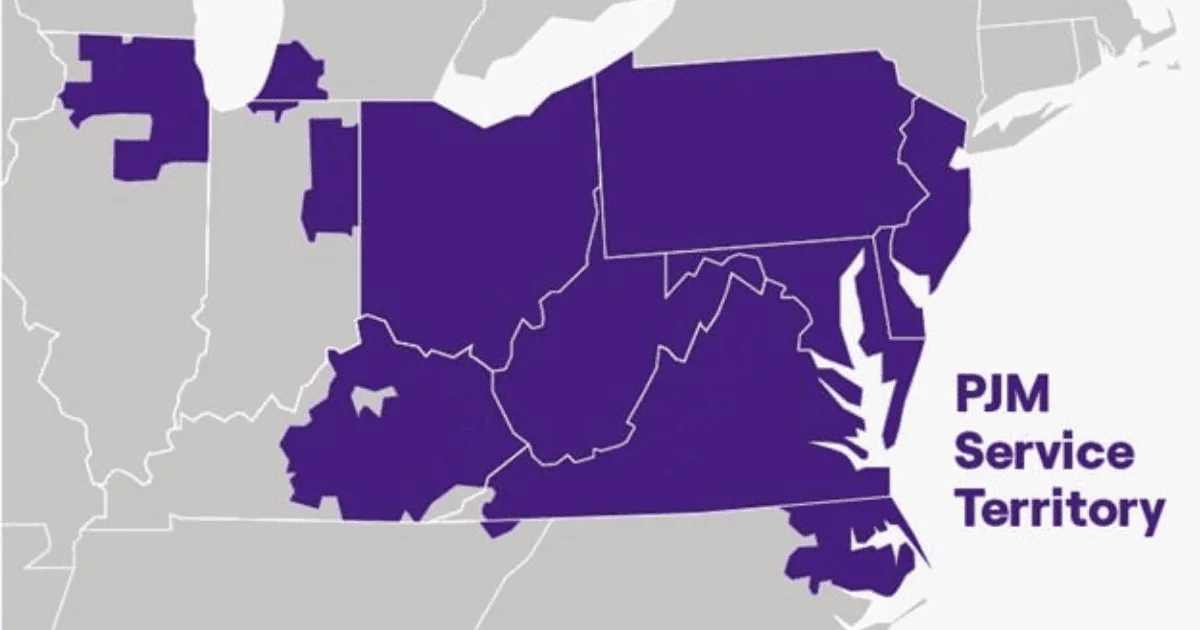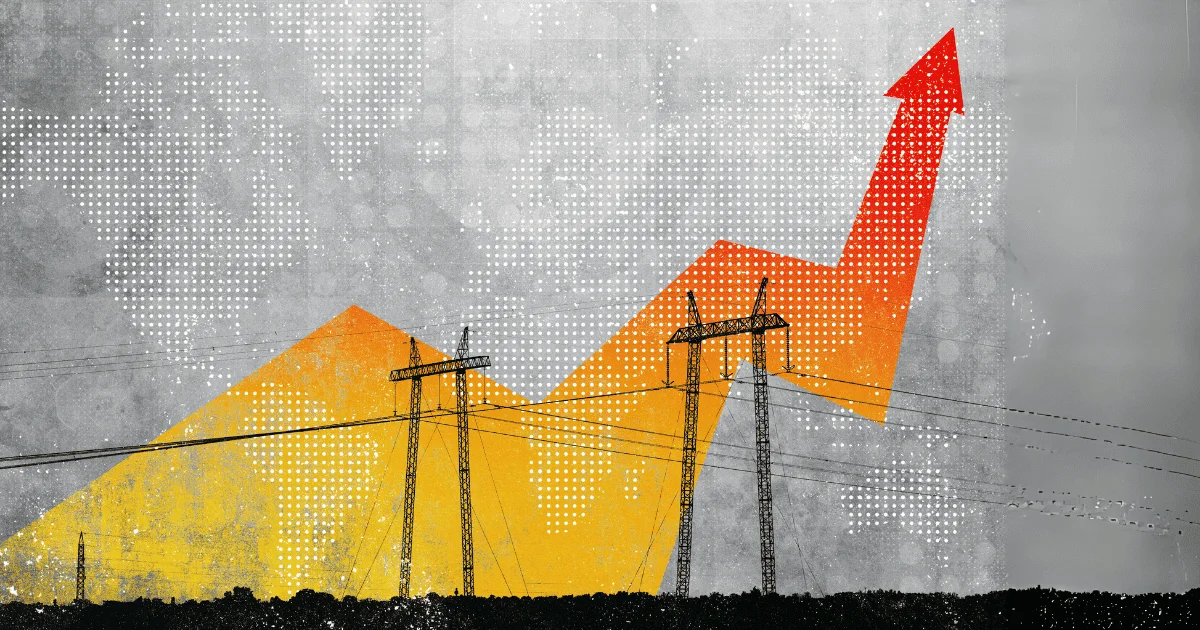Why the PJM Grid Crisis Should Matter To Every Business Leader
Skyrocketing rates. Grid instability. Market chaos. If your business is in PJM territory, your energy strategy isn’t just volatile, it’s a financial liability.
America's largest grid operator, PJM Interconnection, is at a breaking point. As rising AI-driven electricity demand collides with sluggish generation buildout and market dysfunction, the PJM grid is fast becoming a case study in what happens when critical infrastructure is pushed beyond its limits. For businesses across the 13-state region PJM serves, this isn't just an energy story; it’s an operational threat with real financial consequences.
PJM Electricity Prices Are Surging
PJM's most recent capacity auction for the 2026/27 delivery year cleared at a record $329.17/MW-day, with energy costs up 22% from the previous year. In real terms, this means consumers across PJM’s footprint are facing electricity bill increases of up to 5% or more, with some commercial customers already reporting summer surcharges of 10% to 20%. Without last-minute interventions, such as price caps negotiated by state leaders, the spike could have been even worse.

For businesses with high energy usage, from manufacturing to real estate portfolios, these price hikes erode profit margins and increase operational volatility. Energy is no longer a background cost; it's a strategic volatile variable.
AI Demand Outpaces Energy Supply
By 2030, PJM is expected to require an additional 32 GW of capacity, largely driven by the exponential growth of AI and data center demands. Meanwhile, older fossil fuel generators are retiring faster than they're being replaced, and interconnection delays have stalled clean energy projects across the region. In extreme weather scenarios, PJM's own models show that without intervention, parts of the grid could face rolling blackouts.
The grid is buckling under pressure. Supply can’t keep pace, new energy generation is crawling online, and demand is exploding in ways no one can fully forecast. For businesses, this energy volatility isn’t just about potential outages; it’s about runaway costs and unpredictable pricing that turn energy into a major financial liability.

Regulatory Overhaul and Emergency Measures
In July 2025, FERC ordered PJM to overhaul its generator interconnection process, citing failure to meet Order 2023 standards. PJM must now account for energy storage, dispatchable technologies, and grid-enhancing tools while fixing long-standing bottlenecks. Separately, the Department of Energy issued an emergency order allowing a constrained oil-fired unit in Baltimore to exceed pollution limits, enabling it to keep the lights on during a heatwave.
These quick regulatory fixes may buy time, but we’re patching potholes while the road is collapsing, masking a system that is in critical condition.
Take Control With An Energy Command Center
Most businesses are still operating their energy strategies on outdated systems, fragmented or broken hardware, and manual processes, leaving them vulnerable during periods of volatility. Cloud-based Energy Management Systems (EMS) offer a smarter, more resilient approach to energy management, visibility, and control.

Why This Matters:
1) Data-Driven Efficiency:
IoT sensors and cloud analytics enable HVAC, lighting, and plug loads to adapt in real-time, helping reduce energy consumption by up to 50% from optimized HVAC and 30% from plug-load reductions.
2) Grid-Responsive Flexibility:
Modern EMS platforms integrate directly with utility demand-response programs, enabling buildings to participate in PJM’s expanded demand response market (almost 8 GW under contract) and help buffer against peak event stresses through demand response automation, optimization and forecasting.
3) Operational Resilience:
With real-time visibility and predictive alerts, facility managers can avoid downtime, enable building automation, optimize preventive maintenance, and respond to outages or grid signals fast.
An EMS gives you the control to stay resilient, and the intelligence to turn energy from a liability into a revenue stream.
The Rising Role of Demand Response In Energy Strategy
PJM, like other utilities and RTOs, is turning increasingly to demand response programs to balance the grid in tight conditions. With nearly 8 GW under contract, and FERC’s approval to dispatch these resources 24/7, businesses now have more opportunities than ever to monetize their flexibility.
Demand management is no longer just a last-resort emergency measure; it’s becoming a strategic tool for high-consumption businesses to lower costs, reduce strain during grid stress events, and even generate new revenue streams. Participating companies can receive financial incentives for load shedding during peak hours or critical grid events, which not only supports grid stability but also delivers meaningful operational savings.
Whether through on-site generation, load shifting, automated HVAC and lighting control, or participation in demand response, it is evolving from a niche option to a frontline strategy. As energy volatility continues to increase, integrating automated demand management capabilities through systems like Sanalife’s E360 platform allows businesses to act quickly and intelligently, maximizing performance while minimizing disruption.
What Business Leaders Must Do To Navigate The PJM Energy Crisis
To thrive in the PJM region amid rising costs and reliability threats, businesses must adopt a proactive energy strategy. This isn’t just about waiting for regulatory reform; it’s about building agility into your operations today.

Here Are The Immediate Steps:
1) Digitize Your Infrastructure:
Upgrade from legacy energy systems to real-time, cloud-based EMS platforms. These systems integrate building system data into one centralized view. This enables operational teams to be empowered with the data and automation necessary to reduce consumption, optimize performance, and prepare for demand response events.
2) Participate in Demand Response Programs:
With the ability to curtail load and shift operations intelligently, companies can monetize their flexibility and reduce exposure to peak pricing through demand management. For example, Sanalife’s E360 IoT EMS helped Material Sciences Corporation (MSC) significantly improve its demand response performance and reduce load-shedding frequency by 50%.
3) Invest in Flexible Capacity:
Whether through battery storage, DERs, or onsite renewable generation, having dispatchable or shiftable power sources strengthens your resilience.
4) Collaborate with Utility Partners:
Join working groups, advocate for faster interconnection timelines, and demand transparency around grid constraints and capacity pricing.
The Takeaway Is Clear: Energy Strategy Is Business Strategy
Companies that lean into this catalyst for change won't just cut costs; they'll gain resilience and a competitive edge. PJM is a bellwether. What happens here will have a ripple effect across the country. Businesses that adapt early will weather the storm. Those who don’t may find themselves powerless, literally and figuratively. Because in an energy market this volatile, inaction isn’t just risky, it’s a financial liability.
















